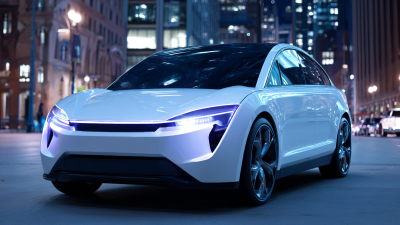As the automotive industry continues to evolve, the rise of EV cars (electric vehicles) has become a pivotal trend reshaping our lifestyles. According to the International Energy Agency, global electric car sales reached 6.6 million units in 2021, a remarkable 108% increase from the previous year, reflecting a growing acceptance and demand for sustainable transportation options. Furthermore, research by BloombergNEF predicts that by 2040, EVs will account for over half of all new car sales, driven by advancements in battery technology and increasing government incentives. This blog will delve into the comprehensive benefits and features of EV cars, highlighting how they can not only enhance your driving experience but also align seamlessly with modern lifestyles, paving the way for a greener and more efficient future.

When considering a switch to an electric vehicle (EV), one of the most enticing benefits is the significant cost savings that come with ownership. Unlike traditional gasoline vehicles, EVs offer lower operating costs, primarily due to reduced fuel expenses. Electricity is generally cheaper than gasoline, and with many EV owners opting to charge at home during off-peak hours, the cost per mile driven can plummet. Additionally, many utilities offer incentives or rebates for EV charging, further enhancing savings.
Another factor contributing to the overall cost efficiency of EVs is their reduced maintenance requirements. With fewer moving parts and no need for oil changes, EVs require less frequent service. Battery technology continues to improve, leading to longer lifespans and warranties that provide peace of mind to owners. Many manufacturers also offer long-term warranties on their batteries, ensuring that significant repairs are less of a concern. This combination of lower fuel costs and reduced maintenance can lead to substantial savings over the lifespan of the vehicle, making EVs not just an environmentally friendly option, but also a financially wise choice for drivers looking to optimize their lifestyle.
When considering the switch to an electric vehicle (EV), understanding charging options is vital to integrate EVs seamlessly into your lifestyle. Two primary charging methods stand out: home charging and public charging stations. Home charging offers convenience, allowing you to plug in your EV overnight and start each day with a fully charged battery. With the installation of a Level 2 home charger, charging times are significantly reduced, giving you that extra peace of mind.
When utilizing public charging stations, it's essential to plan your routes and charging stops, especially for longer trips. Remember, not all public charging stations are created equal; some may offer fast charging, while others may take longer. Familiarize yourself with apps that can help you locate these charging stations and check their availability in real-time.
**Tips:** When installing a home charger, consider the voltage and amperage that best suits your needs to maximize efficiency. Moreover, always keep an eye on public charging networks to understand membership benefits, as some provide discounted rates or faster charging for subscribers. Embracing these charging options can elevate your EV experience and align it with your daily routine.
Electric vehicles (EVs) are transforming the way we think about transportation, significantly contributing to a sustainable lifestyle. According to the International Energy Agency (IEA), the global stock of electric cars surpassed 10 million in 2020, a clear indication of the shift toward cleaner mobility. EVs produce zero tailpipe emissions, which drastically reduces air pollution—one of the major contributors to health issues like asthma and cardiovascular diseases. By choosing an EV, consumers not only reduce their carbon footprint but also encourage cleaner energy practices and sustainable urban development.
Tip: When considering the switch to an EV, investigate local incentives that may cover installation costs for charging stations or offer tax credits. Many regions are implementing policies to support the adoption of electric vehicles, making them more accessible and affordable.
Moreover, EVs help decrease reliance on fossil fuels, aligning with global goals to combat climate change. A study by the Union of Concerned Scientists reveals that, even when accounting for electricity generation, EVs produce less than half the greenhouse gas emissions of comparable gasoline-powered vehicles over their lifetime. This shift not only contributes to cleaner air and a healthier planet but also paves the way for advancements in renewable energy integration with transportation.
Tip: Look into community charging networks, which are increasingly expanding, ensuring that you have easy access to charging capabilities whether at home or on the go.

Electric vehicles (EVs) have rapidly evolved, incorporating advanced technology features that significantly enhance the driving experience. From regenerative braking systems that convert kinetic energy back into battery power to sophisticated infotainment systems, EVs are designed not just for efficiency, but also for comfort and convenience. According to a report by the International Council on Clean Transportation (ICCT), EVs can save drivers as much as $5,000 in fuel costs over the lifetime of the vehicle. This cost-saving factor is complemented by features such as over-the-air software updates, which ensure your car's systems remain cutting-edge without the need for dealership visits.
When considering an EV, it's essential to look for specific tech enhancements that can elevate your lifestyle. For instance, many EVs now include adaptive cruise control and lane-keeping assist, which reduce driver fatigue on long trips. A study from Consumer Reports highlighted that vehicles equipped with advanced safety features can reduce collision rates by up to 40%.
**Tip:** Look for models that offer smartphone integration for seamless navigation and music control, enabling a hassle-free experience. Also, consider EVs with enhanced battery management systems that maximize range and charging efficiency, ensuring you get the most out of every drive.

Transitioning to an electric vehicle (EV) may seem daunting, but with the right strategies, it can be a smooth experience that complements your lifestyle. According to a report from the International Energy Agency, global EV sales reached 6.6 million in 2021, marking a significant increase in consumer acceptance. As more people make the switch, understanding how to navigate this transition is crucial for maximizing the benefits of EV ownership.
One key tip for a seamless transition is to thoroughly assess your driving habits. The average electric vehicle covers around 250-300 miles on a single charge, making them suitable for most daily commutes. Consider adopting a charging routine that fits your schedule; for instance, charging overnight at home can ensure your vehicle is always ready for the day ahead. Additionally, familiarize yourself with local charging stations; a recent survey by the U.S. Department of Energy found that over 100,000 public charging outlets are available nationwide, making it easier than ever to refuel on longer journeys.
Another important aspect is to take advantage of available incentives and rebates. Many governments offer financial incentives for purchasing an EV, which can offset initial costs significantly. For example, in the U.S., federal tax credits can go up to $7,500, and various states also provide additional benefits. Researching and utilizing these incentives not only makes the transition more affordable but also enhances your overall experience with electric mobility.






